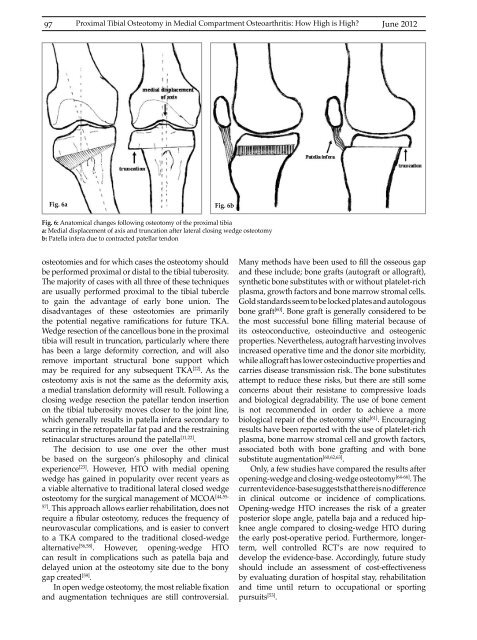Vol 44 # 2 June 2012 - Kma.org.kw
Vol 44 # 2 June 2012 - Kma.org.kw
Vol 44 # 2 June 2012 - Kma.org.kw
You also want an ePaper? Increase the reach of your titles
YUMPU automatically turns print PDFs into web optimized ePapers that Google loves.
97<br />
Proximal Tibial Osteotomy in Medial Compartment Osteoarthritis: How High is High?<br />
<strong>June</strong> <strong>2012</strong><br />
Fig. 6a<br />
Fig. 6b<br />
Fig. 6: Anatomical changes following osteotomy of the proximal tibia<br />
a: Medial displacement of axis and truncation after lateral closing wedge osteotomy<br />
b: Patella infera due to contracted patellar tendon<br />
osteotomies and for which cases the osteotomy should<br />
be performed proximal or distal to the tibial tuberosity.<br />
The majority of cases with all three of these techniques<br />
are usually performed proximal to the tibial tubercle<br />
to gain the advantage of early bone union. The<br />
disadvantages of these osteotomies are primarily<br />
the potential negative ramifications for future TKA.<br />
Wedge resection of the cancellous bone in the proximal<br />
tibia will result in truncation, particularly where there<br />
has been a large deformity correction, and will also<br />
remove important structural bone support which<br />
may be required for any subsequent TKA [22] . As the<br />
osteotomy axis is not the same as the deformity axis,<br />
a medial translation deformity will result. Following a<br />
closing wedge resection the patellar tendon insertion<br />
on the tibial tuberosity moves closer to the joint line,<br />
which generally results in patella infera secondary to<br />
scarring in the retropatellar fat pad and the restraining<br />
retinacular structures around the patella [11,22] .<br />
The decision to use one over the other must<br />
be based on the surgeon’s philosophy and clinical<br />
experience [23] . However, HTO with medial opening<br />
wedge has gained in popularity over recent years as<br />
a viable alternative to traditional lateral closed wedge<br />
osteotomy for the surgical management of MCOA [<strong>44</strong>,55-<br />
57]<br />
. This approach allows earlier rehabilitation, does not<br />
require a fibular osteotomy, reduces the frequency of<br />
neurovascular complications, and is easier to convert<br />
to a TKA compared to the traditional closed-wedge<br />
alternative [56,58] . However, opening-wedge HTO<br />
can result in complications such as patella baja and<br />
delayed union at the osteotomy site due to the bony<br />
gap created [59] .<br />
In open wedge osteotomy, the most reliable fixation<br />
and augmentation techniques are still controversial.<br />
Many methods have been used to fill the osseous gap<br />
and these include; bone grafts (autograft or allograft),<br />
synthetic bone substitutes with or without platelet-rich<br />
plasma, growth factors and bone marrow stromal cells.<br />
Gold standards seem to be locked plates and autologous<br />
bone graft [60] . Bone graft is generally considered to be<br />
the most successful bone filling material because of<br />
its osteoconductive, osteoinductive and osteogenic<br />
properties. Nevertheless, autograft harvesting involves<br />
increased operative time and the donor site morbidity,<br />
while allograft has lower osteoinductive properties and<br />
carries disease transmission risk. The bone substitutes<br />
attempt to reduce these risks, but there are still some<br />
concerns about their resistane to compressive loads<br />
and biological degradability. The use of bone cement<br />
is not recommended in order to achieve a more<br />
biological repair of the osteotomy site [61] . Encouraging<br />
results have been reported with the use of platelet-rich<br />
plasma, bone marrow stromal cell and growth factors,<br />
associated both with bone grafting and with bone<br />
substitute augmentation [60,62,63] .<br />
Only, a few studies have compared the results after<br />
opening-wedge and closing-wedge osteotomy [64-66] . The<br />
current evidence-base suggests that there is no difference<br />
in clinical outcome or incidence of complications.<br />
Opening-wedge HTO increases the risk of a greater<br />
posterior slope angle, patella baja and a reduced hipknee<br />
angle compared to closing-wedge HTO during<br />
the early post-operative period. Furthermore, longerterm,<br />
well controlled RCT’s are now required to<br />
develop the evidence-base. Accordingly, future study<br />
should include an assessment of cost-effectiveness<br />
by evaluating duration of hospital stay, rehabilitation<br />
and time until return to occupational or sporting<br />
pursuits [53] .
















